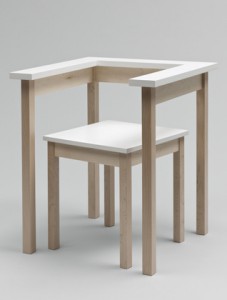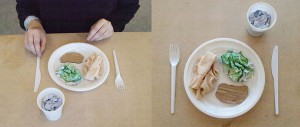Table-chair is a furniture made by Richard Hutten. It’s a two-piece furniture consisting of a chair and a table with an almost shy and invisible character. The interesting thing with this piece is that it’s a illusion of a table and a chair. By closer observation I realize that it’s the relation between the two parts that create the visual expression of a table and a chair, and if you separate them, the expression changes and along with it the whole concept of the furniture. The parts are defined by each other as furniture. Presented separately, you might not even recognize it as a specific furniture. Richard Hutten’s works makes me question what actually constitutes a piece of furniture. It also makes me understand what a big role our associations play when we observe our surroundings. The Table-chair automatically lead our thoughts to a table and a chair, not only by name but also trough its execution. It’s interesting how this piece, with its simple and discreet design, can contain our ideas of what a piece of furniture is.
Perception, function and behavour
A table usually consists of a flat horizontal surface that is held up by a base of one or several supports. The fundamental purpose of the table is to support various objects in order to relate to them; for overview, work, show, storage.
The table is an ultimate tool when eating dinner. It creates conditions for you to perform the activity of eating. The flat surface of the table support the plate and consequently free your hands and makes it possible for you to use the cutlery. By placing the objects on the table, their relation becomes more clear and also their behavior related to the format of the table. A rectangular tabletop requires structure, the objects relates to the straight lines of the edges. When placing my computer on it it’s constantly relate to the lines of the surrounding. I place the laptop in front of me, push it a bit backwards to get enough space for my arms to be supported. The table support my activity with the object.
I place a sheet of paper onto the flat surface of the table, I then place a pen beside, in perfect line with the sheet, unconsciously I move the pen a bit more to the right, I continue moving it back and forth until it feels right. The right balance occurs when all element are taken into account, table, objects and body and even though my actions are based on sense it’s not a coincidence – It’s about being taught how to behave and relate to the table
At first sight the Table-chair of Richard Hutten behaves like any chair and table and therefore I know how to relate to it, but a closer look makes me doubt. This piece of furniture requires a new approach and for that I must forget my conception of what determines a chair and a table.
Within the context
I found myself at the Stedelijk, continuing to observe the Table-chair. One thing is clear; Hutten confuses me. And somehow the object makes me feel tricked. Part of Stedelijk’s design collection, the Table-chair stands on a podium among other famous design-items. Its chosen placement puts Hutten’s work within the context of modern design.
It’s clear that the work is dependent on its two phsyical parts, that together create the image of a furniture. Another important component is its ability to create confusion in the viewer. But also, I wonder if the greatness of Hutten’s furniture depends on the context in which it is shown. Perhaps it’s the context of Design that creates the confusion surrounding the object.
As a distinguished person with a recognized position and an important role within the design world, Richard Hutten can certainly play with the main principles of design. For me, it is obvious that he choose to use the design context, with its limitations as well as its possibilies, to raise issues and questions about how our perceptions and behavior are shaped by of our surroundings.
For me, the most interesting aspect of Richard Hutten’s work is the fact that he makes them as a designer.
Bless you Hutten!





